Watching how tomato seedlings grow and develop, summer residents ask a number of questions: “Do I need to dive tomatoes? Is it necessary to do this? When and how to dive tomatoes? Let's try to answer these questions.
DO YOU NEED TO DIVE TOMATOES?
Previously, the answer to the question of whether it is necessary to dive tomatoes was unequivocal - of course it is necessary! Today, however, opinions differ. Many gardeners argue that when growing tomato seedlings, picking is not necessary at all. Growing tomato seedlings without picking, you can get excellent results. The main thing is to decide in advance how you will grow tomatoes - with or without a pick. The technology of planting tomato seeds for seedlings and caring for seedlings depends on this.
Others, on the contrary, believe that when growing a tomato, picking is indispensable. Since tomatoes tolerate picking quite well, some gardeners do it not once, but twice and thrice as the plants grow.
WHEN TO DIVE TOMATOES?
You need to dive tomatoes when the seedlings have a couple of true leaves. This usually happens 7-10 days after the emergence of tomatoes.
HOW TO DIVE TOMATOES?
- Prepare containers for planting tomatoes and fill them with soil. For picking a tomato, you can use plastic or peat cups. In the latter case, it will be possible to plant tomato seedlings in the ground directly in them.
- A day or two before picking tomatoes, water the seedlings. If you water the tomatoes just before picking, the earth will be very heavy and during the transplant process it may turn out that the earthen lump formed around the root will come off along with a piece of the root system and damage it. If the tomato seedlings are not watered before picking, the dry earth will crumble from the plant, again injuring the roots.
- Using a dive peg, which can be used quite successfully as a toothpick, remove the tomatoes from the seed box.
It is even better not to touch the green part of the plant at all, but in the process of picking, hold the tomato by the ground around the root.
- In accordance with generally accepted recommendations for picking, the main root of the seedling should be pinched 1/3 of its length. However, many consider this procedure superfluous, because during the picking process, the tomato root system is already damaged. And if you also specifically pinch off the root, the tomato will need to spend additional time restoring the root system, which will affect the timing of the seedlings' readiness for planting in the ground. Here, each gardener decides for himself how to dive seedlings: to pinch the root or not.
- Transplant the seedlings into individual containers, deepening the tomatoes almost to the very cotyledon leaves.
- Using the same toothpick, straighten the tomato roots and press them to the ground.
- Fill the hole with soil and lightly press it down at the base of the stem.
- Water the pickled seedlings generously and place the tomatoes in a cool place with high humidity away from direct sunlight. When the seedlings take root, the seedlings should be returned to the windowsill again. This usually happens after a couple of days.
CARE FOR SEEDLING TOMATO AFTER DIVING
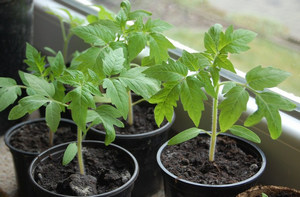
The traditional way growing tomato seedlings involves sowing
If you are growing tomato seedlings at home, then all stages of the process are important, from choosing seeds to planting in the ground. However, the most responsible of them, according to qualified gardeners, is the picking of tomatoes.When they make a pick
If you first encountered the term "tomato pick", then this process means shortening the main (tap) root of plants in order to stimulate the development of a branched root system in seedlings. Not all vegetables planted for seedlings, without exception, are recommended to dive, but in a particular case for tomatoes, this is a necessary process, which, along with root processing, also includes transplanting vegetables into a separate container, more spacious than the one where the seeds germinated.
The first time you can pick tomatoes when the first 2 leaves have developed well on the plant - usually this is around 7-10 days after seed germination. Professionals recommend using the lunar calendar when growing and picking tomatoes. The calendar will tell you exactly when to carry out certain procedures.
Early picking will help each plant develop into a strong bush, but at this stage, seedlings should be handled very carefully to avoid breaking the stem. The root system of the "baby" is 10 times smaller than that of the "adult" tomato, so the seedlings develop normally in the box for some time. If you did not have time to prepare for transplanting each bush into a separate container, then you can use the box again, but with a planting interval of 7-10 cm, so that the tomatoes receive enough light and nutrients.
There are a number of conditions under which picking is recommended:
- If your goal is to get a powerful root system from grown seedlings, then picking will provide you with this by forming a wide network of lateral roots;
- If you did not sow tomato seeds separately in each container, but in a large box, then picking is recommended with transplanting into individual cups for their further healthy development, which will also contribute to the good adaptation of plants when planting in the ground. If you leave the seedlings like this and develop in a bunch in a box, then the plants will be weak, and their roots will become so intertwined that it will not be an easy task to plant them later without damage.
- If you have sown densely, and the seedlings began to form unevenly in strength. In this case, picking will help sort viable plants at an early stage.
- It may happen that the soil you used to germinate the seeds will be contaminated with pathogens, and your young plants will start to get sick. Then picking will become a surgical operation to remove infected plants and transplant healthy ones into new soil. With this event, you will save the rest of the seedlings and stop the disease at an early stage, because exceptionally strong plants are needed for an excellent harvest.
- Even if you have wonderful seedlings, but it developed too early for planting in the ground (the seeds were sown early, the weather let us down, etc.), then picking can slow down the growth of plants. Overgrown tomato seedlings will be very painful to move to a permanent landing site.
How to dive correctly
Gardeners recommend using the lunar calendar to determine the best time to dive tomato bushes. Now let's directly consider the main process of how to dive tomatoes correctly. Watering tomato seedlings before picking.
The well-known vegetable grower Alexander Ganichkin recommends watering the seedlings abundantly a few hours before the start of the process in order to facilitate your work and increase the elasticity of the plants. Earlier watering, as well as immediately before transplanting, will not be correct. In the first case, the earth will be dry, and so the root can be damaged during extraction, and in the second case, earthen clods will stick, and there will be a high probability that the stem will break. Such options do not suit us, so we water, wait 2-3 hours and proceed.
We cover the prepared container for transplantation with soil. Ganichkin recommends not to immediately use a large container for small plants, it is better to take small cups of 100-150 ml. Here, plants can develop without harm for another 2-2.5 weeks, then they will definitely need to dive again into a larger container. Picking immediately into a large container is not recommended due to the fact that a small root system cannot immediately cover the entire volume provided, therefore, various kinds of fungi can begin to successfully develop in the ground. The process of transplanting into large volumes is no different, so having mastered the pick once, you can repeat it without any problems.
First, we dig up the plants from a box with a clod of earth. 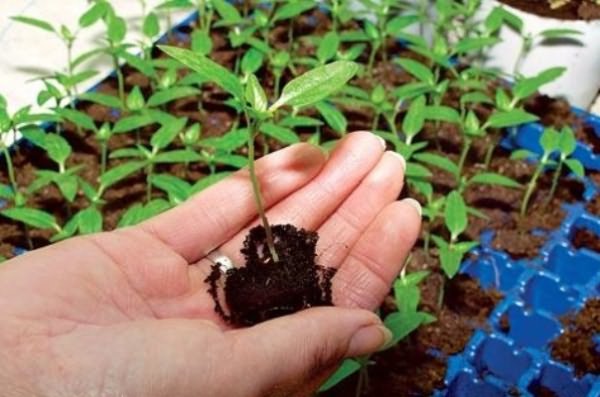 Remember to do this carefully. You can use any handy object: someone digs with a pencil or a sushi stick, someone helps a teaspoon - choose what is convenient for you.
Remember to do this carefully. You can use any handy object: someone digs with a pencil or a sushi stick, someone helps a teaspoon - choose what is convenient for you.
The second step is to separate the plants. It is safe to use a toothpick. Try to touch the seedlings with your hands as little as possible, especially the leaves. It is not necessary to completely clean the earth from the roots - this way the plant will better tolerate the transplant.
Picking may be accompanied by pinching off a part of the central root, but at an early stage this root is so small and thin that in 90% of cases it will be damaged during transplantation, so at this stage root shortening can be neglected. If you pinch off too much, then the tomato will subsequently slow down growth and will use all its strength to restore the root system. This works well when you have overgrown seedlings, and for the "kids" it will become an unnecessary brake on their development.
Then each plant is placed in a hole in a prepared container. It should be planted with a deepening to the cotyledon leaves themselves - this is how you stimulate the formation of a branched root system. We crush the soil around the plant a little.
Immediately after picking, tomato bushes need to be watered. Repeated diving of tomato bushes is carried out if there are 2 true leaves in a large container or if there is not enough space - in the same boxes, only with the replacement of soil and a row spacing of at least 15 cm. The process is similar to that described above. Growing tomatoes also deepen into the ground to the initial leaves. A tool for forming holes for tomato seedlings.
Although picking is not the most time-consuming process, some gardeners do without it at all. Growing tomatoes at home without picking is quite possible, and seedlings are no worse than picking.
Everyone who grows tomatoes in this way claims that the process of plant adaptation when planting in the ground is faster and painless. In this method, in comparison with the classical method of growing home seedlings, differences appear already at the first stage of sowing seeds.
Tomatoes in this case are sown immediately in separate containers, so you will need a sufficient number of them, you also need a relatively large space to accommodate all the seed. If you have a heated greenhouse, then this method is perfect. The choice of the desired container is not limited, the main thing is that it has drainage holes. Therefore, it is also worth taking care of the presence of a pallet. 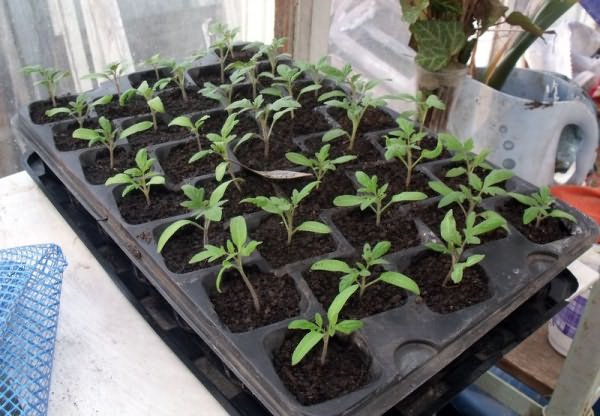
The soil for tomatoes should be loose and fertile. Because you will use the soil throughout the entire cultivation of seedlings, then before packaging it in a container, you need to carry out a disinfection process (you can simply ignite it in the oven).
3-5 germinated seeds are placed in each container with moistened soil to a depth of not more than 1 cm, then watered from a sprayer. Seedling care is standard.
When the plants sprout and grow a little, they need to be thinned out, leaving 2 of the most viable in each glass. At the same time, unsuccessful shoots are recommended not to be torn out, but carefully cut off.
As tomato seedlings grow without picking, in order for the root system to form well, you need to gradually pour the earth into the container. When picking, we deepened the plant during transplantation, but here we use the addition of soil to the level of the leaves.
In the future, you will need to leave only one plant in each pot. If the seedlings turned out to be strong, it is not necessary to throw away the extra bush - transplant it into a separate container, let it develop further.
Video "Picking homemade tomatoes"
A video about how and when to dive seedlings of tomatoes.
plodovie.ru
When to dive tomatoes - how to do it right
Tomatoes are one of the most beloved, popular vegetables on our table, which we surround with care and attention at all stages of growth - before planting in a garden, greenhouse or greenhouse. Do I need to dive tomatoes? The opinion of the majority of gardeners tends to be positive. How and when to dive tomatoes, you will learn in this article.
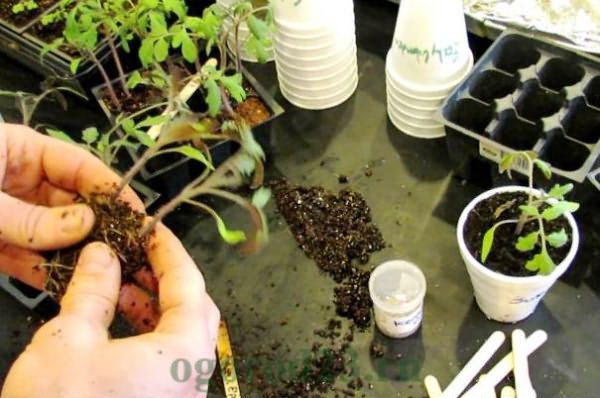 To bring the fruiting time closer, to make the seedling bushes stronger, gardeners use an effective agrotechnical technique - picking. After the tomatoes give the first two or three full-fledged leaves, it is time to dive them - to transplant the bushes into a large container. This method allows seedlings to form a stronger root system, prevents stretching, and allows you to harvest early. When diving, the root of the plant is deepened, this makes it possible to form new lateral roots.
To bring the fruiting time closer, to make the seedling bushes stronger, gardeners use an effective agrotechnical technique - picking. After the tomatoes give the first two or three full-fledged leaves, it is time to dive them - to transplant the bushes into a large container. This method allows seedlings to form a stronger root system, prevents stretching, and allows you to harvest early. When diving, the root of the plant is deepened, this makes it possible to form new lateral roots.
With proper picking, weak specimens are rejected, and promising seedlings are placed in separate pots for subsequent development.
Usually, tomato seeds are sown by the end of the calendar winter (February or early March). If you did everything right in advance: you sowed the seeds, took into account the requirements for lighting, watering, temperature changes during the day and at night, then it's time for a pick.
Tomato seedlings - how to dive?
After a certain time after the emergence of seedlings, it becomes clear which sprouts are weaker. They should be removed so that they do not draw vitality from strong brothers. After about a month, the plants will gain strength, they will have the first real leaves - this will serve as a signal - you can start diving. 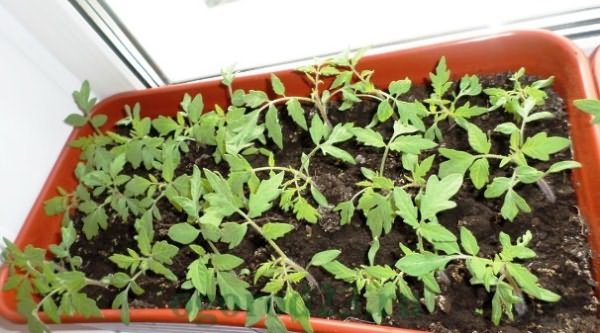
In a few hours, tomato seedlings need to be thoroughly watered, the water temperature should not be lower than + 20 ° C. New containers for seedlings (cups, pots, special shapes) should not be very large, about 8x8 or 10x10 cm in diameter.
If these are not special containers, then you must first prepare them, for example, make holes in the bottom so that the water does not stagnate.  Then you need to fill it with pre-prepared soil, crush the ground a little, make indentations. If you have potassium permanganate at home, then you can make a slightly pink solution and pour it over the soil before planting. In the absence of potassium permanganate, you should simply moisten the hole with water at room temperature - this will positively affect the further survival of tomatoes.
Then you need to fill it with pre-prepared soil, crush the ground a little, make indentations. If you have potassium permanganate at home, then you can make a slightly pink solution and pour it over the soil before planting. In the absence of potassium permanganate, you should simply moisten the hole with water at room temperature - this will positively affect the further survival of tomatoes.
How to dive tomatoes if they were originally sown and grew in a common container? To gently and comfortably remove a tomato bush from the ground, you can take a sharply sharpened wooden stick or a small fork, and then carefully remove the sprout along with the earthen clod. 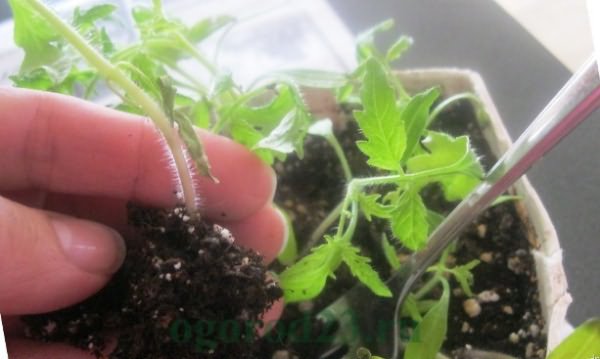 If it does not work out with a lump, then at least do not shake the earth from the roots.
If it does not work out with a lump, then at least do not shake the earth from the roots. 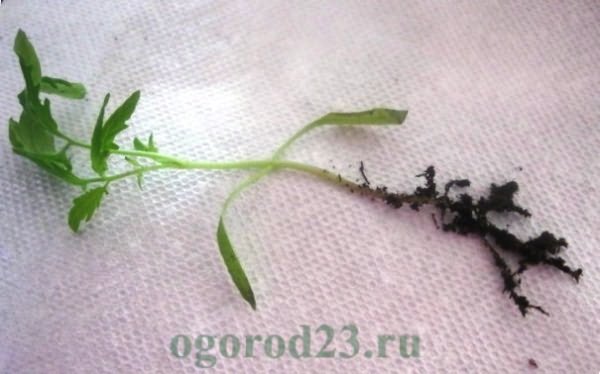 Be careful not to damage the roots, try to keep your hands less in contact with the green part of the seedling. Tender tomato sprouts are very sensitive and the contact of human hands (skin temperature) with the stem and leaves can cause stress, after which the plant can get sick. Try to hold the plant by the part of the stem that is closest to the root, or, even better, by the clod of earth with the root.
Be careful not to damage the roots, try to keep your hands less in contact with the green part of the seedling. Tender tomato sprouts are very sensitive and the contact of human hands (skin temperature) with the stem and leaves can cause stress, after which the plant can get sick. Try to hold the plant by the part of the stem that is closest to the root, or, even better, by the clod of earth with the root.
I know that some gardeners remove cotyledon leaves before picking.
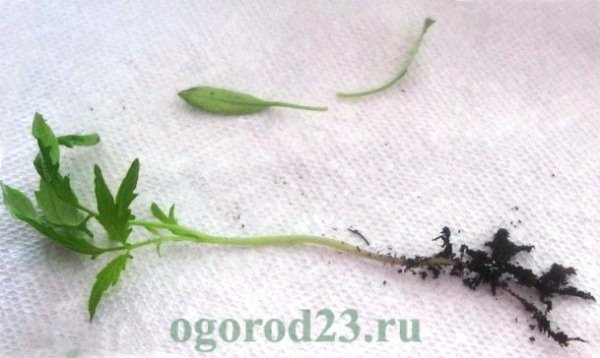
I tried in different ways. Basically, I removed the cotyledon leaves if the seedlings were stretched out,
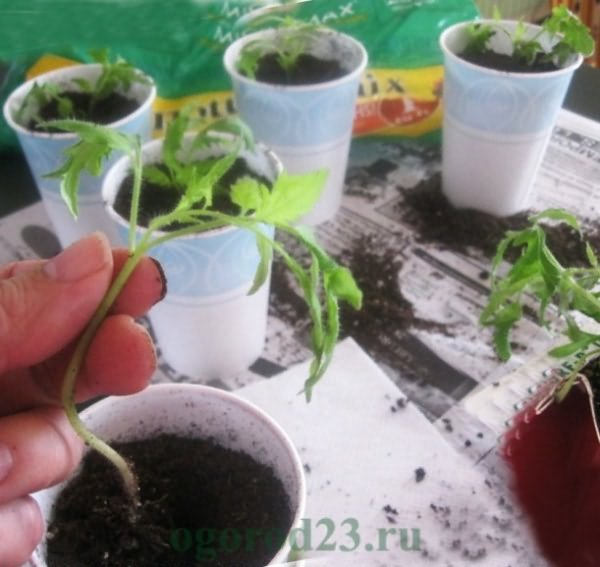
and the plant had to be deepened when picking to slightly retard growth.
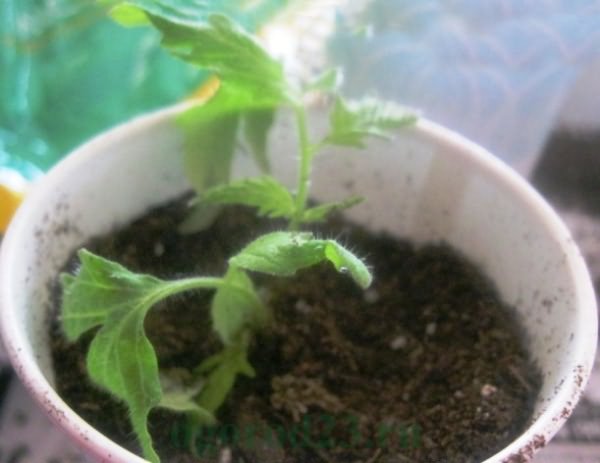
How do tomato seedlings dive if they were previously grown in individual molds or cups? Here the difference is only in the process of extracting the earthy clod along with the sprout. It is much easier to extract a lump from separate molds, for example, by transshipment. To do this, a day and a half before picking, the seedlings are no longer watered, the earth dries out a little and when the mold is turned upside down, the seedling with soil falls out freely. He can be helped by light pressure on the bottom of the container, the stem itself with leaves is passed between the fingers. This method is also good because the roots of the plant are not injured during the process.
How to dive tomatoes if the root system has formed differently? Properly formed roots should be approximately the same in size, resembling a fluffy ball in their structure. Such roots do not need to be pinched and sunk too much into the soil - deepening to the level of the cotyledon leaves will be enough. After that, gently press the earth around the sprout. Too deep penetration negatively affects the further growth of the bush, as it will spend all its strength on the formation of new roots.
If one of the roots is more actively developed than the others, it should be slightly shortened - pinned by about 1-1.5 cm. If you damaged this main tap root when removing the seedling, then you should not worry too much. The favorable development of the urinary system is the main condition for tomatoes; when transplanting a bush to a permanent place of residence, the roots of the plant will deepen exactly as they need (down or to the sides).
Aftercare
After picking, tomato seedlings should be placed in a shady place where they will be hidden from direct sunlight. Daytime temperature should be +20..23°C, nighttime - +15..17°C. After 4-5 days, the seedlings can be irrigated with a spray bottle and poured with water at room temperature. Previously, it is impossible to moisturize, as the roots begin to stretch in search of moisture and, accordingly, grow stronger. As soon as you see that the sprouts have freshened up and taken root in a new place, they can be taken out into the light. 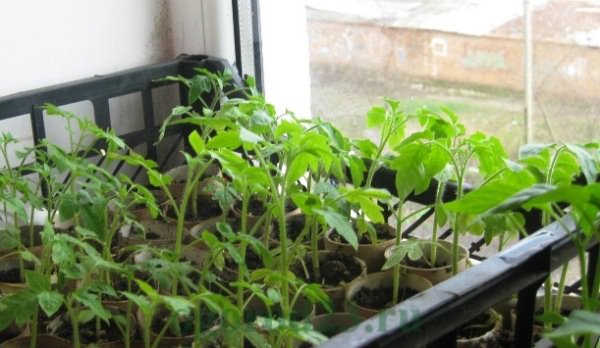 After 10-12 days, make a control inspection: if the tomato seedlings have acquired a juicy green color and put out new leaves, the process was successful.
After 10-12 days, make a control inspection: if the tomato seedlings have acquired a juicy green color and put out new leaves, the process was successful.
Fertilizing is done twice: 2 weeks after picking and 3 weeks after the first fertilization. Top dressing for tomato seedlings is important - they have a beneficial effect on root development, growth, and fruit formation. For these purposes, complex mineral supplements that contain potassium sulfate, superphosphate, ammonium nitrate, and urea are well suited. After top dressing, the seedlings must be watered with clean water (as if washing off fertilizers) and gently loosen the ground.
Additional questions on picking
Is it possible not to dive tomato seedlings?
The answer to this question will be positive - yes, you can. In such cases, the sowing of seeds is carried out about a month later (end of March-beginning of April). Sow either directly into the ground (in established warm weather) or in a greenhouse. Seeds are pre-soaked for several hours and sown with a rare step - this is a seedless way of growing tomatoes.
Top dressing with urea or nitrophoska will favorably affect the general condition and development of the bushes. When two full-fledged leaves (not cotyledons) appear, the tomatoes are thinned out - they simply pinch off weak sprouts with a fingernail. After 3 days, the seedlings are fed with a solution of saltpeter (15 mg / 10 l of water), about 1 liter of fertilizer is poured under each bush. The second, potassium-phosphorus top dressing is done before the fruits grow.
Also, the seeds can be sown immediately in separate pots, and then transplanted into the soil in the garden by the method of transshipment, bypassing the picking process.
What to do if tomato seedlings stretched out to a pick?
Seedlings are stretched due to lack of light. This is a natural process, as all plants reach for the sun. A similar phenomenon can also be observed when the bushes are planted too close (common tray, not individual molds), they do not have enough light, because they block it from each other.
Another reason is non-compliance with the temperature regime. Seeds need warmth to germinate, but when the seedlings have already seen the light, the temperature must be lowered so that they do not actively grow until the moment of picking.
To remedy the situation, tomatoes should be transplanted into boxes, having previously formed elongated grooves in the ground. fertile soil must be mixed with humus and sand; before planting tomatoes, the furrow itself must be watered with warm water. The seedling is placed in a groove, tilting the earthen ball with roots at an angle of 45 degrees, while the roots lie, and the top is visible on the surface. The root system is carefully covered with earth, then the rest of the plant.
Thus, new roots will grow on the stem buried in the soil, it will straighten up and will bear fruit normally, except perhaps a little later. The same method is used when bushes are planted in open ground to a permanent place of growth. To give a horizontal direction to the bushes, tying is additionally used. Support pins are installed along the edges of the grooves, between which ropes are stretched, to which the stem is neatly tied.
There is another method of “resuscitation” of elongated seedlings: before diving, they pinch off the elongated top of the sprout, do it in such a way that a stem fragment of about 1 cm remains above the cotyledon leaves. After that, the seedling is dived into a separate container and buried in the soil as usual (up to cotyledon leaves). A transparent plastic cup is put on top of the pot or a plastic film is stretched. After 7-10 days, a new full-fledged leaf appears on the remaining stalk.
We hope that after reading this information, you figured out why dive tomatoes.
Perhaps you will choose a seedless way of planting tomatoes or do without a dive stage by planting the bushes extracted from the cups directly into the ground.
It all depends on your preference and the time available.
Sometimes, in order to strengthen the seedlings, to avoid stretching the sprouts, gardeners use a double or even triple pick, each time planting the bushes in a large container.
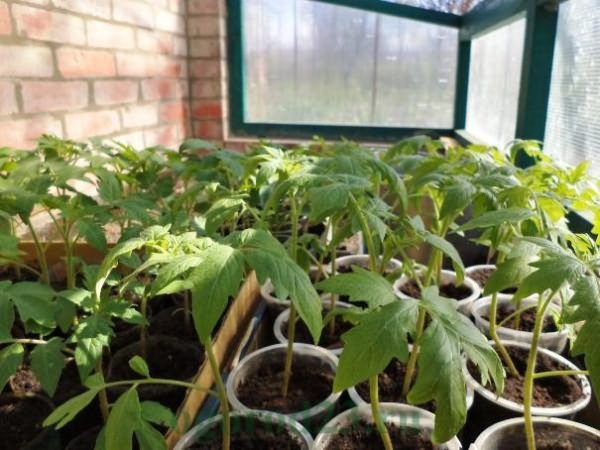
In any case, now you know when to dive tomatoes, we hope that the results of this method will be beneficial and will delight you with a generous harvest.
garden23.ru
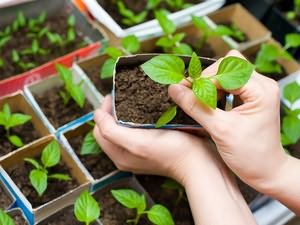
Is it worth diving pepper seedlings? Pepper diving helps to stimulate the growth of the root system. The seeds sown first in the "school", where there is not a large amount of soil, does not allow the plant to "fat", but stimulates the reaction of the rapid formation of the plant, aimed at the formation of the fruit. The instinct laid down by nature works perfectly, and we only help the plant to cope with all the difficulties. Subsequent picking helps to gradually expand the nutritional area for the crop and cause flowering and fruiting.
You will need
- 1. "School" with seedlings
- 2. nutrient soil
- 3. peat pots
- 4. scoop
- 5. water for irrigation
- 6. spray bottle for watering
Instruction
Pepper is a very heat-loving crop and is therefore grown through seedlings. The seedlings in the “school” have grown up and picking is necessary for the further development of strong and healthy peppers. We start planting pepper seedlings from the moment 2-3 true leaves are formed. At this time, the root system grows and requires a large area of nutrition for the further development of the culture, and the leaves begin to close, shading the neighboring plant. It is during this period that the seedlings painlessly tolerate transplantation and quickly take root. Plants should not be allowed to overgrow - this will lead to seedlings stretching, and you will get weak pepper bushes with low yields.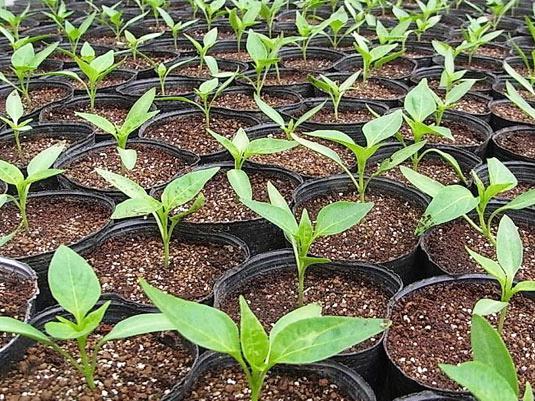
- For picking seedlings, there is a large number of cups: plastic, peat and made at home from improvised material, it is important that they are with drainage holes and a volume of at least 0.5 liters. Before planting seedlings, we water 2-3 hours before diving, the moisture should be absorbed a little and be looser during transplantation. We fill the prepared, preferably peat pots with moist soil to a height of 2/3 of the pot, make a recess in the center and place the entire root system of seedlings into it evenly, without creases and bends. We transplant seedlings carefully, trying not to damage the root. We press the soil around the stalk with our fingers and sprinkle the soil. The depth of planting of seedlings should not exceed half of the subcotyledonous chill. The stem of the pepper is not able to form additional roots like tomatoes, so deepening can lead to rotting of the stem in the region of the root collar. To prevent the appearance of a "black leg", the soil for picking and water for irrigation should be warm. After planting the seedlings, sprinkle the surface of the soil with hot river sand. Planted seedlings are watered and temporarily shaded until turgor is restored.
- For the normal development of seedlings, nutrition is necessary. The first top dressing is carried out two weeks after picking, and the next one 10 days later, with organic or any complex fertilizer. A sign of good development of the peppers is that the crown will be light green, while the bulk of the leaves are dark green. Pepper does not like compaction of the soil, therefore, loosening of the top layer of soil is periodically carried out. After closing the leaves, we place the pots away from the "neighbors". We plant seedlings in a greenhouse at the age of 60-75 days, a well-developed plant has 8-11 leaf blades, stem branching, 2-3 flowers and initial fruit set.
KakProsto.ru
The middle of March is coming, and the gardeners have taken up the problems of growing tomato seedlings. Which is better: grow seedlings yourself or buy from private traders or in greenhouse farms?
Here are the main advantages of self-growing seedlings:
You know your varieties; - you can add new varieties to the permanent assortment; - you have a supply of seedlings in case of frost after planting tomatoes in the ground; - it is generally dangerous to buy from private traders, since they mainly strive to make the seedlings look beautiful, but in the end you grow incomprehensibly what small tomatoes; - it is better to buy in greenhouse farms than from private traders, but they mainly use varieties that behave well during cultivation.
When should you start growing seedlings?
It depends on the region and varieties of tomatoes. The best thing is to focus on the gardener's calendar in your region. Before planting seeds, they can be disinfected by soaking for 30 minutes in a weak solution of potassium permanganate or aloe juice with water. Then the seeds must be washed in running water. However, many gardeners believe that this is not necessary.
Soil is better to buy in specialized stores. If you have stored land from your dacha since autumn, then you can add it.
The earth must be well moistened before planting the seeds. In order for the seeds to germinate faster, you can close the jar with the planted seeds with polyethylene and put in a warm, dark place (for example, under the battery). Seeds are planted in small containers not very densely, because then, if they begin to sprout together, the seedlings will have to be thinned out.
But it is necessary not to guard the time when shoots appear. Then the container with seedlings should be placed in a bright place. If you have a north side, you can make a foil screen before seedlings so that there is additional reflected light. Seedlings need light and coolness, otherwise it will begin to stretch, and then it will hurt when planted in the ground.
When to dive seedlings?
Picking tomatoes consists in transplanting them into separate pots. In order for the root system to develop well, a third of the root must be cut off. But not all of this procedure is considered beneficial for plants. Seedlings dive when the stalk is quite thick and 2-3 main (not cotyledon) leaves have appeared. The timing of the picking is very important, since diving too early can ruin the seedlings, and too late can lead to the fact that it will then develop poorly.
It is hardly worth planting seedlings in peat pots, as they dry the ground very much. Seedlings can be planted in dairy bags or in special pots. Many cut plastic bottles from above, and plant seedlings in such a container. When you need to transfer the plant to the ground, it is watered, the jar is pressed from all sides, and the seedlings, together with the ground, come out of the jar well.
Such jars can be stored for subsequent years. The milk bag can be cut off from the bottom and the seedling completely pulled out along with the ground for planting in the ground. During the growth of seedlings, it is necessary to sprinkle the earth from time to time for the development of the root system.
As soon as it becomes warm outside, the dishes with plants are transferred to the balcony. It is necessary to monitor day and night temperatures. Do not water the plants too often, otherwise they may rot the stem and roots.
When to plant seedlings in the ground or greenhouses?
For the northern regions, it is better to plant seedlings in greenhouses. For the average climatic zone of Russia, plants develop well in the ground. Good seedlings have a thick stem and dark green leaves. In regions of Siberia, frosts occur until mid-June. But here is a double-edged sword: I don’t want to ruin the seedlings, but I want to get the harvest earlier. It makes sense to plant part of the seedlings earlier, but follow the weather forecast and have covering material in case of frost. In case of any cataclysms, you still need to have a supply of seedlings. Do not aim for the seedlings to be too tall. If she has an average stem height of 10 - 15 cm, then she will better take root in the ground and not get sick.
If you prepare well for planting tomato seedlings in the ground, the first harvest can be obtained as early as early July.

Every spring, summer residents start growing seedlings of vegetables and, in particular, tomatoes. Many of them already have some experience in this business. However, there are those who for the first time decided to try their hand at this kind of occupation. But for those and others, the question often arises of how to dive tomatoes, and when is it better to do it. Therefore, we will devote today's article to this topic, so that novice gardeners can correctly carry out the procedure and get a good harvest as a result.
Like sowing seeds, picking tomato seedlings is an important step in the growing process. There are two simple ways how to plant seedlings, which we will discuss below.
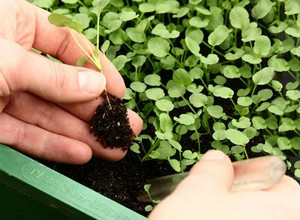 In simple words, picking is the transplantation of seedlings that have reached a certain size in a container, the volume of which is much larger than the previous ones. The primary goal of the procedure is the culling of weak shoots. But also picking tomatoes is necessary so that the roots develop correctly and fully, and the seedlings do not stretch.
In simple words, picking is the transplantation of seedlings that have reached a certain size in a container, the volume of which is much larger than the previous ones. The primary goal of the procedure is the culling of weak shoots. But also picking tomatoes is necessary so that the roots develop correctly and fully, and the seedlings do not stretch.
It is necessary to dive seedlings of tomatoes, depending on which variety you decide to grow, and when the seedlings were planted.
In general, tall varieties of vegetable crops should be transplanted 2 times, and undersized and medium height bushes - once.
The first picking of tomato seedlings should be carried out 10-14 days after the day when the crop seeds were planted in the ground. At this point, the stems will have a pair of true leaves. The container must be chosen deeper than the original volume. 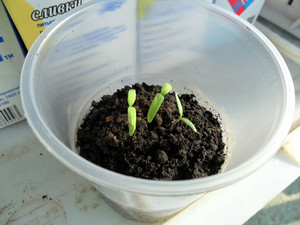 The second procedure for transplanting seedling sprouts can be done after 20-22 days. Beforehand, it is worth preparing a container, the volume of which will be 1.5-2 times more than the previous one. In order for the seedlings to take root and fully develop after the procedure, it is necessary to water the plants abundantly in a day.
The second procedure for transplanting seedling sprouts can be done after 20-22 days. Beforehand, it is worth preparing a container, the volume of which will be 1.5-2 times more than the previous one. In order for the seedlings to take root and fully develop after the procedure, it is necessary to water the plants abundantly in a day.
Some summer residents may have a question why it is worth diving into tomato seedlings exactly at this time. The answer to it is based on the characteristics of the development of seedlings. So, for example, if plants are transplanted earlier than the specified period, then the root system that has not yet strengthened can be injured. If transplanted later, the roots can also be damaged, especially if the planting was in groups, and vegetable seedlings were placed very densely.
Transplant procedure step by step
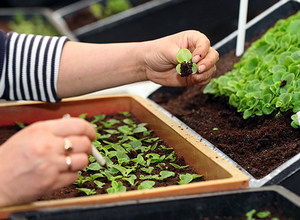 As previously mentioned, picking tomatoes can be done using one of several existing methods. Today we will describe the two most common:
As previously mentioned, picking tomatoes can be done using one of several existing methods. Today we will describe the two most common:
- the "traditional" picking method used by most gardeners;
- a more modern method used for plants planted in separate containers.
The "traditional" way of transplanting
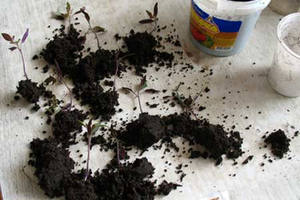 This method of picking tomatoes is used when the seedlings were planted in one container. When group planting, it is correct to transplant seedlings into large containers with the appearance of the first pair of leaves. As mentioned above, this happens about 10-14 days after the sowing date.
This method of picking tomatoes is used when the seedlings were planted in one container. When group planting, it is correct to transplant seedlings into large containers with the appearance of the first pair of leaves. As mentioned above, this happens about 10-14 days after the sowing date.
For the procedure, you will need to prepare in advance:
- containers with a volume of 0.7-100 ml and a height of 12-15 cm;
- priming.
First you need to prepare the container for growing seedlings in it.
To ensure good aeration and removal of excess water after watering, holes should be made in the containers. Then you can fill them with soil.
For growing tomatoes, a regular mixture is suitable, which goes on sale marked "For seedlings." After that, the picking of tomatoes can be carried out.
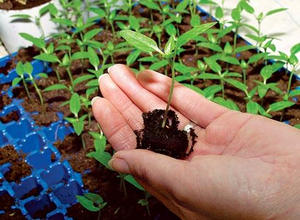 It is worth noting that it will be possible to transplant tomato sprouts with minimal damage to the roots, if the soil is well wetted in advance (for 1-2 days). Thus, when you start the procedure, the plants will be freely removed from the soil.
It is worth noting that it will be possible to transplant tomato sprouts with minimal damage to the roots, if the soil is well wetted in advance (for 1-2 days). Thus, when you start the procedure, the plants will be freely removed from the soil.
Now it’s worth taking each prepared container with soil and making a recess to the very bottom with a pencil. Then pour water at room temperature into the hole. It will take about 100-200 ml, depending on the size of the container. While the water has not yet been absorbed into the soil, we place the seedling and compact the soil around it. Lower the sprout into the hole should be up to the cotyledon leaves.
It is not recommended to immediately moisten the soil with a dived stem. In order for the sprout to take root well, the liquid that you poured into the recess will be enough. The first watering after transplanting seedlings should be done after 4-7 days. Further, you can moisten the soil with tomato seedlings 1 time in 5-6 days, depending on the growing conditions.
Transplanting sprouts germinating in separate containers
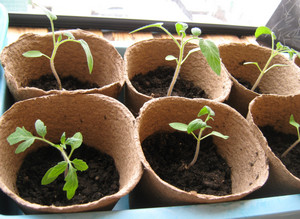 With this method, tomato seedlings are transplanted, the seeds of which were originally planted in separate containers. As a rule, plastic disposable cups are used for these purposes. Tomato picking should be carried out, as in the previous method, when the sprouts reach the age of 10-14 days. By this time, each stem should already have a pair of full-fledged leaves.
With this method, tomato seedlings are transplanted, the seeds of which were originally planted in separate containers. As a rule, plastic disposable cups are used for these purposes. Tomato picking should be carried out, as in the previous method, when the sprouts reach the age of 10-14 days. By this time, each stem should already have a pair of full-fledged leaves.
To dive seedlings of tomatoes, you need to prepare:
- fresh soil;
- larger containers.
Seedlings are transplanted by transshipment. To do this, you need to take a new container and make holes in each to drain water. Then you should fill in fresh soil for about 1/3 of the container. After this, it is necessary to remove the seedlings, trying not to damage the root system. To do this, we remove the pre-moistened soil with a paska from the cup and put it in a new dish. With the remaining soil, we fill the space between the walls of the container and the earthy clod with tomato roots.
This picking method is more laborious. However, the result lives up to expectations and the seedlings are strong and have a stocky appearance.
This ensures the integrity of the roots of the stems, which, in turn, allows you to increase the yield.
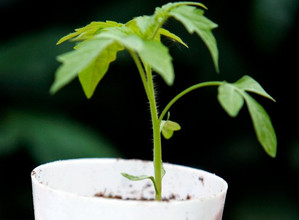 There are cases when the picking of tomatoes, carried out correctly and on time, stops the growth of the stems.
There are cases when the picking of tomatoes, carried out correctly and on time, stops the growth of the stems.
Firstly, the growth of seedlings may stop if they were picked directly into the cold ground. To stimulate the further development of seedlings, you need to overlay containers with seedlings with bottles, filling them with hot water.
Similar situations also arise when the soil turns sour. You can prevent this by sprinkling the soil on top with a small layer of ash and thoroughly loosening the surface.
With the onset of the summer season, gardeners are interested in when to dive tomatoes after germination. This question is debatable, some summer residents prefer to do without this procedure, others believe that in order to approach the time of fruiting and get a good harvest, picking tomato seedlings is simply necessary.
What is a pick? After the appearance of a pair of true leaves, the strongest shoots are selected and moved to separate containers, and the weak ones are removed so that they do not interfere with the development of more promising ones. The essence of picking is the transplantation of a growing seedling to a large feeding area in order to improve the characteristics of the plant. Sometimes gardeners additionally pinch the central root to form a fibrous root system.
Preparing for a dive of tomatoes
Why do you need a pick:
- Transplanting helps develop a strong root system. When diving, the root is deepened, lateral roots are formed.
- Stretching of the stem is prevented, the bush becomes stronger.
- Thanks to this formation of roots, you can get the first harvest faster.
- Sorting sprouts allows you to select and prepare the best of them.
- After picking, tomato bushes take root better in the soil, which increases the likelihood of good fruiting.
Is it possible to do without picking? Yes, if the tomatoes are grown in a dry region or the soil is not planned to be watered frequently. In this case, it is better for the root to grow deep into the ground so that the plant does not have a moisture deficit. If the summer period is short, then it is better not to waste time on the additional development of the root system in order to have time to harvest before the cold snap. If you want to enjoy the maximum result in the future, then it is wiser to choose for planting in the open field. They will provide the culture with the necessary nutrients.
Picking time for tomato seedlings
Tomato seeds are sown from late February to early March. If all conditions are met (watering, lighting, temperature), then after 3-7 days sprouts appear. After 2 weeks, the seedlings should form the first leaves. Seeds are sown tightly, since not all of them can germinate, but continued existence at close range affects the extension of the stem, the bush grows weakened.
The pick is made 10-15 days after the appearance of the first leaves (not counting the cotyledons). It is important to remember that you can not dive tomatoes ahead of time, since you can easily damage a weak root system.
If you are late with a pick, then the roots can intertwine with each other, it will be difficult to separate them.
When is the best time to start picking tomatoes? Some summer residents prefer to dive seedlings according to the lunar calendar. It's no secret that the phases of the moon affect crops. Picking is best done on the growing moon. auspicious days different every year, most often occur in the second decade of the month. Using the lunar calendar and observing the seedlings will provide additional confidence in the quality of the work performed. If, then urgently need to look for reasons. Common mistakes in care sometimes lead to this result.
Pick rules
How to dive tomatoes? Picking is carried out in 5 stages:
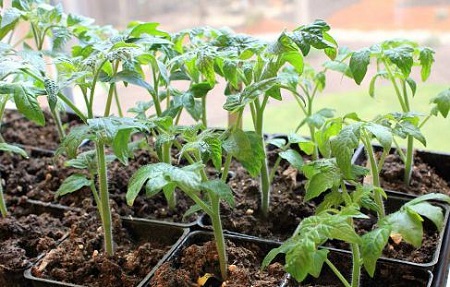
Special boxes, pots or cassettes are suitable for diving. They can be purchased at a special garden store or you can make your own. The composition of the nutrient mixture:
- peat - 1 part;
- humus - 1 part;
- sod land - 1 part;
- sand - 1/3 part.
To improve the properties of the soil, you can add 1 cup of ash and 1 tbsp. l. complex fertilizer (for 1 bucket of the mixture). The composition of the fertilizer should be: iron, manganese, phosphorus, potassium, copper. Such fertilizer can also be purchased at a specialty store.
It is better to buy a container with holes in the bottom so that the moisture in the container does not stagnate. Well, if the height of the container is approximately equal to the diameter. Experienced gardeners do not recommend using dairy products as a container. Lactic acid bacteria remaining on the walls of the package can adversely affect the formation of the root system.
How to dive tomatoes so as not to damage them? Approximately 10-12 hours before digging, the soil must be well shed with water. This will ensure a gentle separation of the roots from the soil. The transplant containers are filled with soil mixture, then watered with a warm solution of potassium permanganate (1%). You should not completely fill the containers with earth, as the seedling will need only 3-4 cm. After the soil dries out a little, it must be loosened.
Video with tips from an agronomist about all the tricks of a dive.
Seedlings should be removed by digging in order not to damage the roots. The seedling is held by the cotyledon leaves. At this stage, you can additionally pinch the main root to form a strong fibrous root system. In the place where the sprout will sink, you need to make a small indentation. The seedling is immersed to the cotyledon leaves so that additional roots can form on the base of the stem. If the warm season does not last long, then you should not bury the seedling too deep to save time, which will be spent on the growth of additional roots.
Rules for placing seedlings in containers:
- One seedling is planted in separate cassettes or pots.
- If the tomatoes are planted in a box, then the seedlings are placed in 2 rows in a checkerboard pattern. This required condition for uniform nutrition and illumination of growing bushes.
Caring for pickled tomatoes
After picking, seedlings take root within 8-10 days. After that, you can make the first top dressing. To do this, use water-soluble fertilizers, which can be purchased at a special summer cottage store. The second feeding is carried out after 3 weeks.
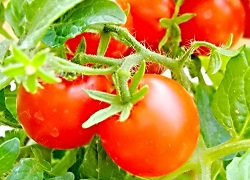
Appetizing and healthy tomatoes
Tomatoes are moisture-loving and heat-loving plants, so you need to monitor soil moisture and provide them with proper lighting. Excessive growth of bushes should not be allowed. Such tomatoes develop slowly, are more susceptible to diseases, and give a poor harvest. So that the seedlings do not outgrow, gardeners use the following technique: as the upper leaves grow, the lower leaves are cut off. If the tomatoes are still outgrown, it is possible, when planting in a permanent place, to deepen their roots by 40 cm and additionally spud. These measures will force the plant to form additional roots instead of stem growth. If everything is clear with picking, then it is worth studying the process in advance to ensure the formation of the proper number of ovaries on each plant.
Preparing for a transplant to a permanent place
Before planting in a permanent place, tomatoes must be prepared for the conditions in which they will have to exist. If tomatoes are planted in a greenhouse, then it is enough to take them out there for several hours in 7-10 days, gradually increasing the residence time. After the plant hardens, it can be planted.
How to determine when to plant tomatoes in a greenhouse or open ground? There are several signs that indicate the readiness of seedlings for transplantation:
- the height of the tomatoes before planting should be 25-30 cm;
- stem diameter - 8-10 mm;
- number of leaves - 7-9;
- the presence of the first flower brush.
Landing is carried out in calm weather. Immediately after planting, the soil is watered abundantly. The optimal landing time is the beginning of June. For best result you can re-dive seedlings. Do not forget about, they will protect plantings from illness and provide an abundance of fruits.
If the gardener successfully copes with all stages of picking, then he is guaranteed an excellent harvest of his favorite vegetable.
Growing tomatoes in your backyard, you may be faced with the question of whether they need to dive.
Why dive tomatoes?
Proper picking of a tomato helps to determine the strongest and most promising seedlings in order to later transplant them for growing in more comfortable conditions. Weak and diseased seedlings are discarded.
How to properly dive tomatoes?
Tomato seedlings can be dived when the first two leaves appear on the seedlings. An earlier or, conversely, late (when 3-4 leaves appeared) picking of tomato seedlings can cause the tomatoes to take root poorly and be prone to frequent diseases.
The procedure for diving tomatoes is as follows:
- About two hours before the start of the pick, seedlings in containers must be watered. So clods of earth with roots will be better separated from the main mass. It is advisable not to touch the stem itself and the leaves, as the temperature of human fingers is much higher than the temperature of the seedlings. If you take the stem with your hands, then the plant may experience stress from such a high temperature. If necessary, it is better to use rag gloves.
- Next, we prepare small pots and planting soil (a mixture of soddy soil, peat and sand), the temperature of which should be kept at 20 degrees. To avoid damage to seedlings, we water the soil in pots with a weak solution of potassium permanganate.
- Carefully remove the seedlings from the ground with a small wooden spatula, toothpick or any other medium-sized object.
- In a pot of soil, make a small hole about 5 cm deep with your finger.
- Pour water into the hole.
- Slowly we plant a seedling in a hole. Cotyledon leaves should be above the ground.
- After planting, we compact the ground with a finger.
- We place the seedlings in a shady place.
- We water once or twice a week.
As soon as the seedlings have taken root, the seedlings must be rearranged in a sunny place. It is also important to periodically ventilate the room in order to harden the tomatoes. Optimum temperature environment- 15-18 degrees.
Feeding tomatoes after picking
After you decide to pick a tomato, you need to apply fertilizer. They will help strengthen the root system and will contribute to more active growth of tomatoes.
Do top dressing twice:
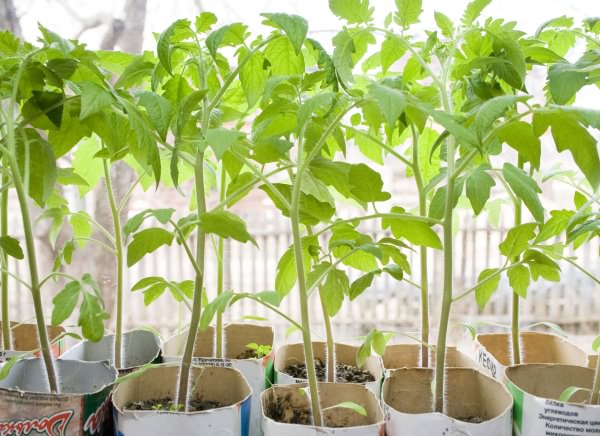
You can use any mineral complex fertilizer containing superphosphate, urea and potassium sulfate.
After fertilizing, be sure to water the seedlings to wash off the remaining fertilizer. After watering, light loosening of the soil is carried out. As a result of a properly carried out pick, you will get tomato seedlings with a powerful root system, which means that later you will have beautiful and large tomatoes with excellent taste.
womanadvice.ru
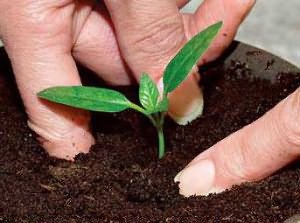
One of the stumbling blocks for many gardeners in growing their own seedlings is the question “How to dive tomatoes?”, And other vegetable crops for seedlings (eggplants, peppers, cabbage). The procedure for all of them is almost the same, so the advice of an experienced vegetable grower can be safely applied to all of the listed crops, including many flower seedlings.
We will not talk for a long time about how everyone loves tomatoes, and how capricious they are in growing. We'll just give helpful tips how to properly grow your healthy seedlings, when to sow seeds, and when picking tomatoes is done, what to do with it after planting in a greenhouse or soil.
The beginning of the tomato road to harvest
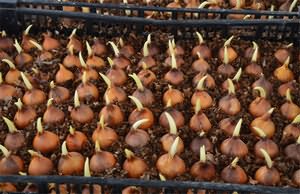
You need to start by preparing the site for planting tomatoes, but this is a separate issue. For seeds for seedlings, the path to life begins in late February - early March.
First of all, they need to be checked for germination: dissolve 5 g of salt in 100 g of water, pour out the seeds, shake well and leave for 10 minutes. Healthy and full-fledged seeds will sink to the bottom, while empty and diseased ones will float on the surface. They must be drained, the rest washed with running water and subjected to treatment in a solution of trace elements. You can buy it ready-made (complex fertilizer diluted 10 times) or cook it yourself in this composition for 1 liter of water:
- 0.5 g of boric acid;
- 0.1 g of manganese sulfate;
- 0.03 g of copper sulfate;
- 0.05 zinc sulfate.
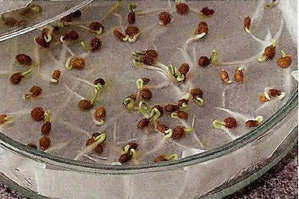
The second option: for 100 g of water, take 15 mg of boric acid and copper sulfate. Soak for at least 12 hours, and preferably all 24. By the way, soaking in a solution also shows just an excellent result. succinic acid, heated to 50 degrees (2 mg per 100 g of water). Wrap the container for slow cooling. It is advisable to stir the solution with seeds every hour or two. Then recline on a sieve and put on germination in a damp place or sow directly into the ground. When germinating, the seeds peck for 4-5 days at a temperature of 25-28 degrees. In the soil, germination begins from 7-8 days.
Preparation of soil mixture for seedlings
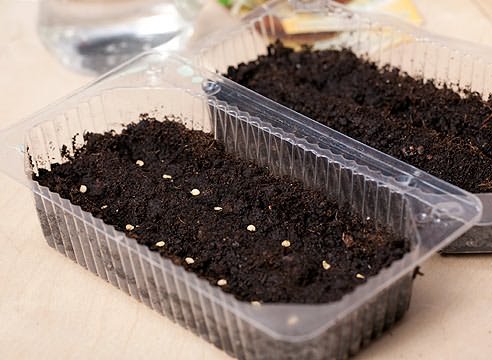
Now rarely anyone cooks it on their own, mostly they buy ready-made substrates. But, unfortunately, there are no less unscrupulous manufacturers in this market, as in other areas. And what kind of soil is packed in a beautiful bag - a non-specialist will not be able to determine, and very often it is just peat with a small addition of mineral fertilizers, which is sold under the big name - seedling soil. Therefore, it will be more correct to prepare the soil yourself, especially when there is no confidence in the quality of store-bought ones. To do this, carefully mix the following components:
- 5 parts of humus;
- 1 part dried manure;
- 1 part of sod land.
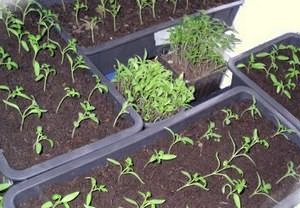
Mix it all in a bucket, adding a glass of wood ash without large inclusions and 3 matchboxes of superphosphate. With quality humus, you will not be upset that the seedlings are ugly and pale, which often happens with store mixes.
Next, you need to sow in seedling boxes in rows. There are two ways to do this: dry the seeds and sow them thickly, and then thin out or spend time and spread them out with a distance of 1.5-2 cm between the seeds that have hatched (you can do two for a guarantee) - so in the future it will be much easier to dive tomatoes.
Sowing is carried out in this order - the soil must first be poured with warm water, let it soak, drain the excess from the pan, slightly compact the soil.
Next, spread the seeds and sprinkle with a layer of dry soil by 1-1.5 cm, lightly press. Then every day it is necessary to moisten the surface with a fine spray. For germination, boxes should be placed in a warm place, without light. But when the first sprouts hatch, the seedlings are immediately exposed to the light.
The temperature regime for growing seedlings
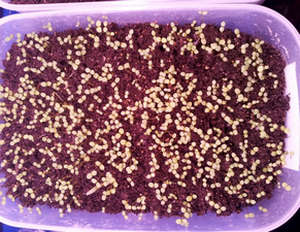
After the appearance of sprouts, the high temperature is no longer needed, so 12-17 degrees will be enough during the day, and 10-12 at night. Such harsh conditions for 4-5 days are needed so that the seedlings do not stretch to the detriment of the development of the root system. After the specified time, the seedlings must be returned to heat: during the day 20-25, at night - the optimum temperature is about 15 degrees.
Lighting
Of course, young sprouts of tomatoes lack the meager March sun even on the southern windowsill. Illumination is necessary, otherwise the seedlings will stretch. Best to use fluorescent lamps, which must be placed at a height of 70 cm above the plants. The backlight mode is this - turn it on at 6 in the morning, turn it off at 18 - this is quite enough for the seedlings to grow strong and stocky.
Dive process
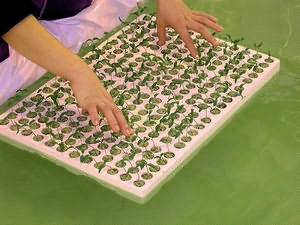
When the seedlings grow to the second true leaf, a pick of tomatoes is necessary. It is necessary to prepare in advance - fill seedling cups, pots, cassettes with soil mixture (in the same composition as described above). The optimal dimensions are a diameter of 6-8 cm, a depth of 8-10. Pour the soil should be 2/3 and pour warm water. The soil will sag almost half the pot - that's right. You also need to water the seedlings and let the water soak in. The next step is to take a wide wooden stick (from ice cream) or a plastic one, which is used to stir coffee in street cafes and gently pry the sprouts at a distance of about 1.5 cm from the stem to a depth of at least 2.5-3 cm. Remove them with a lump soil. Next, separate the stems with your hands, trying to save the soil on the roots as much as possible, and place the sprouts in a new place. Sprinkle each with soil, lightly press and water. After the soil settles, add it almost to the edges of the pot.
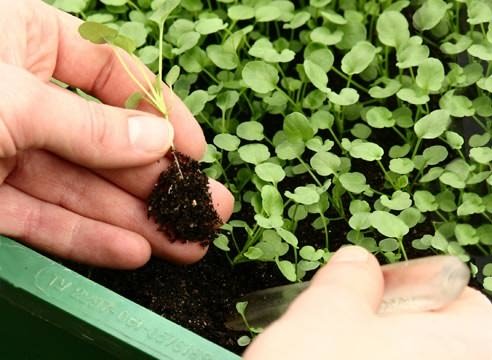
Thus, the sprout turns out to be buried almost to the lowest leaves - this will be correct, since the tomato will release additional roots from the stem. In principle, this is the end of the picking of tomatoes, and the seedlings in cups should migrate for a day or two to a shaded place for plants to take root. The next day, watering must be repeated, and then - as needed, so as not to overmoisten the soil, otherwise the seedlings may get sick with a black leg.
The scheme of watering dived seedlings - on cloudy days three times a week, on sunny and hot days - every day.
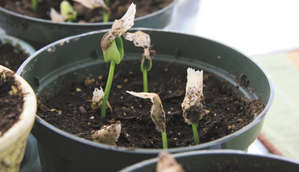
During the picking, it is strictly forbidden to pull the sprouts out of the soil - this will damage most of the suction roots, and the seedlings will recover for a long time - the growth retardation will be almost two weeks.
In a month, the seedlings will be ready for planting in greenhouses. If you plan to plant it directly on the beds, then you can perform another transplant - but by transshipment into a large container. In order for the seedlings to grow strong and green, every 10 days it must be fed with a liquid solution of fertilizers.
LetovSadu.ru
Tomato dive: when and how to dive tomatoes
Watching how tomato seedlings grow and develop, summer residents ask a number of questions: “Do I need to dive tomatoes? Is it necessary to do this? When and how to dive tomatoes? Let's try to answer these questions.
Do I need to dive tomatoes?
Previously, the answer to the question of whether it is necessary to dive tomatoes was unequivocal - of course it is necessary! Today, however, opinions differ. Many gardeners argue that when growing tomato seedlings, picking is not necessary at all. Growing tomato seedlings without picking, you can get excellent results. The main thing is to decide in advance how you will grow tomatoes - with or without a pick. The technology of planting tomato seeds for seedlings and caring for seedlings depends on this. You can read about how to grow tomatoes without picks here.
Others, on the contrary, believe that when growing a tomato, picking is indispensable. Since tomatoes tolerate picking quite well, some gardeners do it not once, but twice and thrice as the plants grow.
When to dive tomatoes?
You need to dive tomatoes when the seedlings have a couple of true leaves. This usually happens 7-10 days after the emergence of tomatoes.
How to dive tomatoes?
- Prepare containers for planting tomatoes and fill them with soil. For picking a tomato, you can use plastic or peat cups. In the latter case, it will be possible to plant tomato seedlings in the ground directly in them.
- A day or two before picking tomatoes, water the seedlings. If you water the tomatoes just before picking, the earth will be very heavy and during the transplant process it may turn out that the earthen lump formed around the root will come off along with a piece of the root system and damage it. If the tomato seedlings are not watered before picking, the dry earth will crumble from the plant, again injuring the roots.
- Using a dive peg, which can be used quite successfully as a toothpick, remove the tomatoes from the seed box.
It is even better not to touch the green part of the plant at all, but in the process of picking, hold the tomato by the ground around the root.
- In accordance with generally accepted recommendations for picking, the main root of the seedling should be pinched 1/3 of its length. However, many consider this procedure superfluous, because during the picking process, the tomato root system is already damaged. And if you also specifically pinch off the root, the tomato will need to spend additional time restoring the root system, which will affect the timing of the seedlings' readiness for planting in the ground. Here, each gardener decides for himself how to dive seedlings: to pinch the root or not.
- Transplant the seedlings into individual containers, deepening the tomatoes almost to the very cotyledon leaves.
- Using the same toothpick, straighten the tomato roots and press them to the ground.
- Fill the hole with soil and lightly press it down at the base of the stem.
- Water the pickled seedlings generously and place the tomatoes in a cool place with high humidity away from direct sunlight. When the seedlings take root, the seedlings should be returned to the windowsill again. This usually happens after a couple of days.
You can read about further care for tomato seedlings here.
swoman.com.ua
When and how to dive tomato seedlings?
Just the other day, I picked a tomato, although I planted them this year a little later than usual, not at the end of February, but at the beginning of March. The pick is carried out when the plant has two true leaves, that is, not two very first cotyledons, but two more. Before picking, the seedlings are watered so that it infuses and becomes more elastic, strong. Boxes with earth are prepared in advance, which are pre-treated from pests and fungus, and this earth is also spilled with water. Then, with a narrow spatula, we remove the plant from the ground and place it in a specially prepared hole. At the same time, we pinch the main root simply with our nails for a third of the length. We plant the seedlings to the cotyledon leaves and slightly compact the ground around the seedlings. Then again we water and clean for 2 days from the sunny side.
Olga Blg
When and how to dive tomato seedlings?
- This is the transplantation of plant sprouts from a common container to individual ones.
Plant picking is carried out in order to select the strongest plants with a well-developed root system, while rejecting weak, diseased plants and plants with a thin root system.
Tomatoes, or tomatoes as we call them, respond very well to a pick.
It is necessary to dive tomatoes in the phase of the appearance of two true leaves. In this case, the central root should be pinched by one third for the development of the root system. The stem should be buried in the ground to the cotyledon leaves. When planting in a pot (cup), the earth should not reach the edges. It is necessary to leave free space so that in the future it will be possible to make additional bedding of the earth.
If the seedlings were originally grown in peat tablets, then this will avoid damage to the root system during a dive: the plant is dived along with a clod of peat.
After picking, reduce lighting for 2-3 days. This is a period of adaptation. After this period, the seedlings should receive as much light as possible to prevent the seedlings from stretching. Tomato seedlings should be watered rarely, but plentifully. And be sure to carry out hardening of seedlings before planting it in open ground.
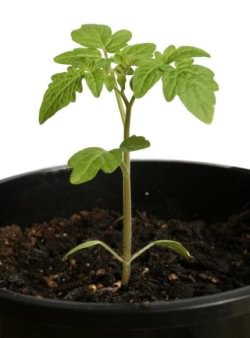
lady v
When to dive: Ideally, when two true leaves appear. Maybe three, no big deal. It is possible even when only cotyledons, and seedlings began to die from the black leg. Then it’s better to transplant them into new soil in this form. And give the opportunity to grow additional roots on the stem.
How to do it right: pinching the main root and deepening into an individual glass almost to the cotyledon leaves. A glass should be taken 500 ml, do not add 3 centimeters of earth to the edge and use a long stiletto stick for planting so that you can make a hole almost to the bottom of the glass. New roots will form on a buried stem - the key to a good plant development. Firm the soil around the stem and water to avoid air pockets.
Elena Lilia
Tomato seedlings should be dived when the plants have 3-4 true leaves. This must be done in order to provide the plant with more favorable conditions for growth and development. It is necessary to choose a larger box and plant the plants less often or place each plant in separate containers. When transplanting, you can pinch the central root by about a third, then lateral roots will develop better. When transplanting, seedlings can be deepened to seven-lobed leaves, additional roots will form on the trunk. After transplantation, the plants must be removed from the sun, they can be treated with an immunostimulant for growth, for example, epin, zircon, silk.
angry
When 2-3 true leaves appear at the seedlings, then it already needs to dive. To do this, take small pots (I take disposable cups of 200 ml), fill them with earth, pour warm water over them and leave for a while so that the earth is saturated with water. With one hand, grab a fake tomato leaf, and with the other hand, using a stick or spoon, pull out the sprout along with a clod of earth. Transfer to a glass and deepen to the cotyledon leaves.
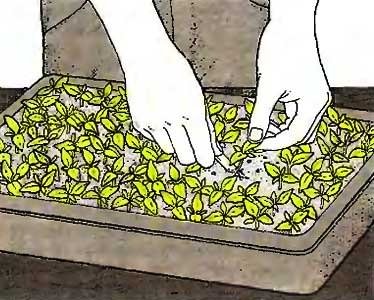
olasneg
Properly, you need to dive seedlings when two true leaves appear. This is about ten days old seedlings. Longer is not very good, the roots will get mixed up and damaged when picking. You need to plant carefully, deepen to the cotyledons.
